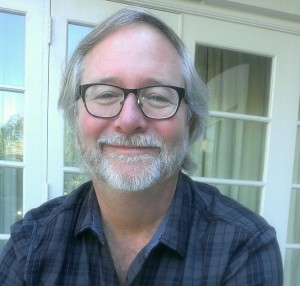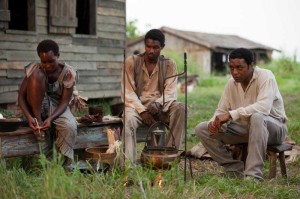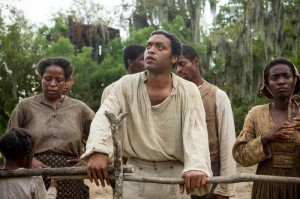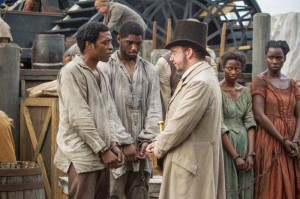
Director of photography Sean Bobbitt, in his long-term collaboration with English director Steve McQueen, is known for his unflinching gaze in photographing movies like Shame (2011), about a depraved sex addict. Nowhere does this unwillingness to look away have a greater impact than in 12 Years a Slave, a current release based on a true story set in the Deep South in the pre-Civil War era. It is derived from the recently-discovered memoir of Solomon Northup, a free black man from upstate New York who is entrapped and abducted, then sold into slavery where he suffers the most extreme cruelties and depredations, along with other slaves, working on a cotton plantation, before managing to escape nearly a dozen years later.
“To his credit from day one Steve recognized the difficulties and complexities, and physical and emotional demands that the film would make,” Bobbitt noted. Several scenes, including severe whippings and an excruciatingly protracted near-lynching of Northrup, are more visceral and realistic than probably any that have been put on the screen in previous movie depictions of slavery.

The power of these scenes is heightened by Bobbitt going for long, unrelenting takes. “The camera gives the audience a chance to bear witness,” said the DP. “We didn’t want to be manipulated by the pacing of the cutting or the juxtaposition of images, but by simply observing what’s happening. By extending the lengths of the shots people are forced to engage and deal with them. It’s a counterpoint or antidote to most films, where the emotion or movement is in the edit, the montage.” Bobbitt, who was the camera operator, also went in for extreme close-ups and used formal framing.
McQueen initially gained renown as a video artist in London. “One thing Steve discovered from his artwork, if you hold an image for a long period of time it has an inherent emotional effect, you are drawn into it and there’s no escape,” the cinematographer observed. “As soon as you put an edit in, the audience subconsciously are told they are in a film. If you don’t put the edit in, they are caught up with what is happening.”
The quick 35-day shoot began at Felicity Plantation in Vacherie, Louisiana, close to where Northup actually spent his years in bondage. Bobbitt shot with an Arri film camera mounted with Cooke lenses.
“You can’t deny the natural beauty of the locations,” said Bobbitt. “We didn’t want to make it gritty or documentary-like. The beauty makes the horror palatable so the audience doesn’t immediately turn it off and reject the film.”
 Indeed, 12 Years is visually lush and sweeping in its story-telling, an antithesis to Gone With the Wind, which depicted slave owners as paternalistic. “For a film that’s two-and-a-half hours, you want to have that complexity and completeness of imagery to hold the audience, but it’s ultimately the amazing performances of Chiwetel Ejiofor (Solomon Northrup), Michael Fassbender (the plantation owner), and the rest of the cast that accomplish that,” he noted. “We wanted elements of the classic epic in it so when people sat down for it, it would feel like a big film and it would feel like an important film. But from my point of view as a cinematographer, I’m very pleased that people not only say they love it and that it’s beautiful, but more significant is that it has affected them emotionally, and that they’re talking about it.”
Indeed, 12 Years is visually lush and sweeping in its story-telling, an antithesis to Gone With the Wind, which depicted slave owners as paternalistic. “For a film that’s two-and-a-half hours, you want to have that complexity and completeness of imagery to hold the audience, but it’s ultimately the amazing performances of Chiwetel Ejiofor (Solomon Northrup), Michael Fassbender (the plantation owner), and the rest of the cast that accomplish that,” he noted. “We wanted elements of the classic epic in it so when people sat down for it, it would feel like a big film and it would feel like an important film. But from my point of view as a cinematographer, I’m very pleased that people not only say they love it and that it’s beautiful, but more significant is that it has affected them emotionally, and that they’re talking about it.”
Most of the influences on the film came from paintings rather than cinema. “We didn’t look at any other films about slavery, because we felt we were trying to do something different and unique,” he explained. “But we did do what Steve and I always do, which is to immerse ourselves deeply into the subject.” Production designer Adam Stockhausen “came up with loads of amazing early photography that were very helpful for setting the tone of the look.”
 Bobbitt, 54, was born in Corpus Christi, Texas, but moved to England with his family at the age of six. He cut his teeth as a news cameraman and war journalist, then turned to cinema. McQueen first sought him out after seeing his work in Wonderland, directed by Michael Winterbottom. “Steve’s wife said, ‘this is someone you should be working with.’” Their first collaboration was on Western Deep, an art installation piece that was shot in an African gold mine two miles underground, the deepest in the world, depicting the extreme regimentation of the workers.
Bobbitt, 54, was born in Corpus Christi, Texas, but moved to England with his family at the age of six. He cut his teeth as a news cameraman and war journalist, then turned to cinema. McQueen first sought him out after seeing his work in Wonderland, directed by Michael Winterbottom. “Steve’s wife said, ‘this is someone you should be working with.’” Their first collaboration was on Western Deep, an art installation piece that was shot in an African gold mine two miles underground, the deepest in the world, depicting the extreme regimentation of the workers.
His and McQueen’s first feature film was Hunger (2008), based on a true story about Irish Republican Bobby Sands, who led inmates of a Northern Irish prison in a highly-publicized hunger strike. McQueen won the BAFTA for most promising newcomer and Bobbitt got the British Independent Film Award for technical achievement.
Bobbitt has had a busy 12 months with credits on a half-dozen features. Besides 12 Years, he was DP on Oldboy directed by Spike Lee which comes out later in November and was one of a half-dozen cinematographers on another Winterbottom film, Everyday, also due out later this month. He photographed Neil Jordan’s Byzantium and The Place Beyond the Pines helmed by Derek Cianfrance. And he recently completed Kill the Messenger, a CIA drama directed by Homeland’s Michael Cuesta.





